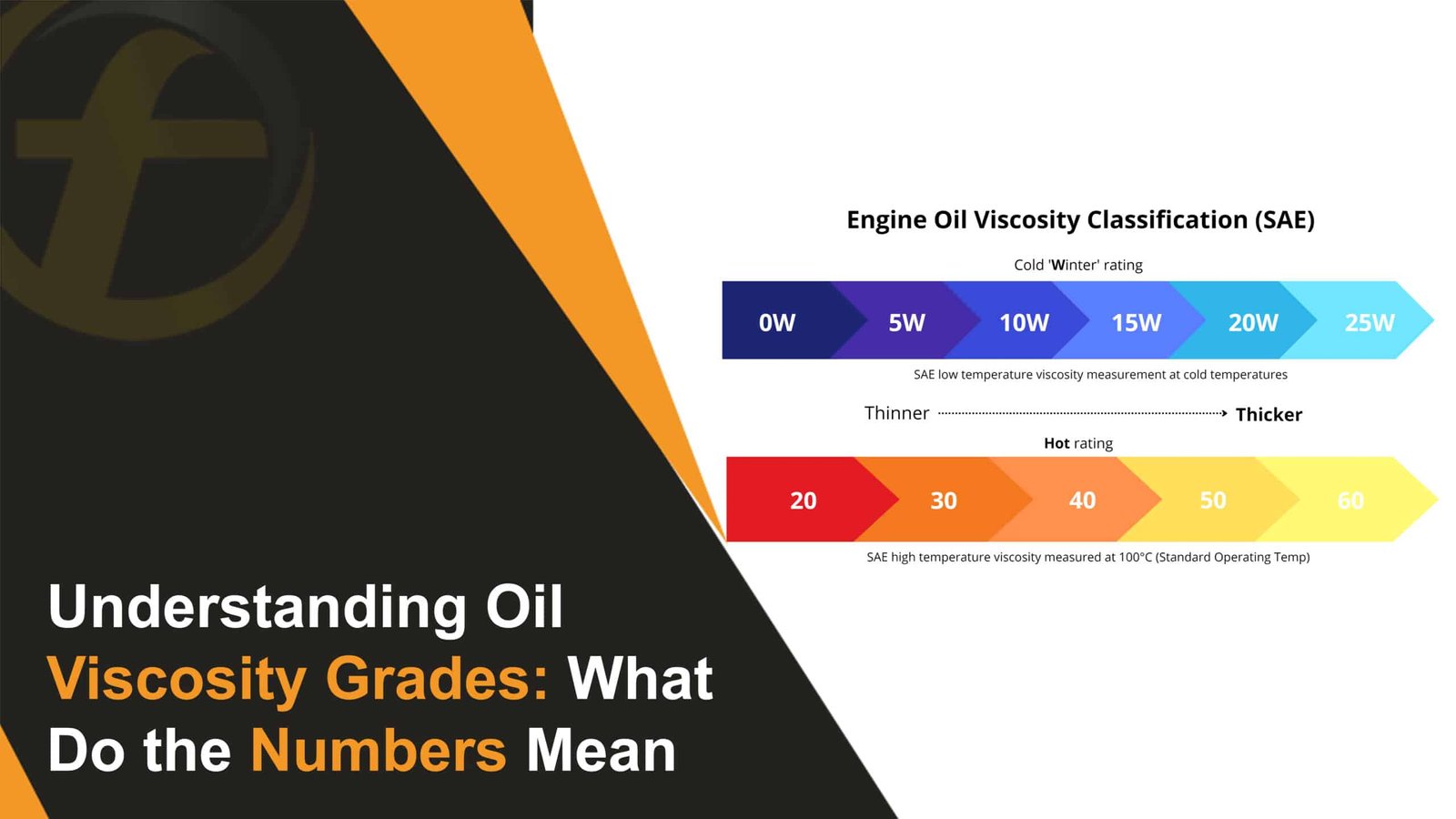
Choosing the right oil for your car is really important to keep your engine healthy. One key thing to know is “oil viscosity,” which tells you how thick or thin the oil is. The numbers on the oil bottle, like 5W-30 or 10W-40, show how the oil works in cold and hot temperatures.
Thinner oil (like 5W) is better in cold weather because it flows easily. Thicker oil (like 40) is better in hot weather because it protects the engine better. Knowing which oil to use helps your car run smoothly and prevents damage, no matter the weather!
What is the Viscosity Grade of Engine Oil?
The viscosity grade of engine oil tells us how thick or thin the oil is and how easily it can move through the engine.
- If the oil has a low viscosity grade, it is thinner and flows more easily—like water.
- If it has a high viscosity grade, it is thicker—more like honey—and moves slower.
Engine oil changes how it flows depending on the temperature:
- In cold weather, thinner oil (low viscosity grade) is better because it moves quickly and protects the engine when you start it.
- In hot weather or high heat, thicker oil (high viscosity grade) is better because it stays strong and protects engine parts from rubbing and wearing out.
Picking the right viscosity grade is very important. The right engine oil helps your car run smoothly. It cools the engine, reduces friction, stops damage, cleans out dirt, and even helps prevent rust and corrosion.
What Are the Common Types of Motor Oil?
Before we begin, let’s get one thing straight—motor oil and engine oil mean the same thing. So, don’t worry if you hear both. Now, let’s talk about the different types of motor oil and what they do.
Conventional Oil
This is the oldest type of oil. It’s made from natural oil that comes from the ground, called crude oil. It’s cleaned and mixed with special ingredients to help it work better.
- It’s the cheapest oil.
- But it needs to be changed more often than other types.
Synthetic Oil
This oil is made in a lab using chemicals. It’s made to handle hot and cold weather better and helps the engine run more smoothly.
- It lasts longer than regular oil.
- You usually change it after 10,000 to 20,000 miles.
Synthetic Blend Oil
This one is a mix of conventional and synthetic oils. It’s like a middle option.
- It gives some of the benefits of synthetic oil but costs less.
- It doesn’t last as long as full synthetic oil, but it still does a good job.
High Mileage Oil
This oil is made for cars that have been driven over 75,000 miles. Older engines need extra care, and this oil helps protect them.
- It can help reduce oil leaks and save fuel.
- It’s a good choice for older cars.
Motor Oil Grades Made Easy
Have you ever looked at a bottle of motor oil and seen something like 5W-40? It might look confusing, but it’s actually pretty easy to understand!
Motor oil grades tell you how thick or thin the oil is in cold and hot weather. This helps your engine work properly all year round.
What Does 5W-40 Mean?
Let’s break down 5W-40:
- The “W” stands for winter.
- The number before the “W” (like the 5) tells you how the oil works when your engine is cold—like in the morning or during winter.
- A smaller number means the oil is thinner and moves faster in the cold.
- So, 5W oil is better for cold weather than 10W or 15W.
- The number after the “W” (like the 40) tells you how the oil works when your engine is hot and running.
- A bigger number means the oil stays thicker when the engine gets hot.
- This helps protect your engine parts from wearing out.
Which Oil Should You Use?
- If you live in a place that gets cold, use oil with a low first number, like 0W or 5W.
- If you live in a hot place, use oil with a higher second number, like 40 or 50.
Always check your car manual or ask a grown-up mechanic to pick the right oil for your car.
What Are the Different Viscosity Grades of Engine Oil?
Picking the right engine oil is important for your car. Engine oil has something called viscosity, which means how thick or thin the oil is. Some oils are better for cold weather, and others are better for hot weather.
To help people choose the right oil, the Society of Automotive Engineers (SAE) made a system that uses numbers and letters to show how thick the oil is in hot and cold temperatures.
Monograde Oils (For One Season Only)
Monograde oils are oils that work well in either cold or hot weather—but not both. These are usually used in older cars.
- For cold weather, pick an oil with a “W” in the name. “W” means winter.
- Examples: SAE 0W, 5W, 10W, 15W, 20W, or 25W
- These oils are thinner, so they move easily when the engine is cold. That helps your car start better in winter.
- For hot weather, choose oil without a “W.”
- Examples: SAE 30, 40, 50, or 60
- These oils are thicker and help protect your engine when it’s hot outside.
Multigrade Oils (Good for All Seasons)
Multigrade oils are the most common type today. They work great in both cold and hot weather. This means you don’t need to switch oils when the seasons change.
You’ll see them labeled like this:
5W-30, 10W-40, or 15W-40
Let’s break that down:
- The first number (like 5W) shows how the oil works in cold weather.
- The lower the number, the better the oil flows when it’s cold.
- The second number (like 30 or 40) shows how the oil works in hot weather.
- A higher number means the oil stays thick and protects your engine when it gets hot.
So, a 5W-30 oil flows easily in winter and protects your engine in summer, too!
How Temperature Affects Engine Oil
Temperature changes how engine oil works. It’s important to use the right oil so your engine stays safe and runs well.
When It’s Cold (Cold Starts)
On cold mornings, your engine needs oil that can move fast. If the oil is too thick, it won’t flow quickly. This means the engine parts might not get oil right away, which can cause them to wear out faster.
That’s why, in cold weather, it’s better to use thin oil that can flow easily and protect the engine when you start it.
When It’s Hot (High Temperatures)
When it’s hot, or your car runs for a long time, the oil needs to stay thick enough to protect the engine. If the oil gets too thin, it won’t cover the engine parts well, and they could overheat or get damaged. That’s why, in hot weather, thicker oil works better.
Why It Matters
Using the right oil for the temperature helps your engine last longer and run better. Some oils, called multigrade oils, are made to work in both cold and hot weather.
Common Viscosity Grades
Motor oils are labeled with numbers like 5W-30 or 10W-40. These numbers help explain how the oil works in both cold and hot weather.
What Do the Numbers Mean?
Let’s look at 5W-30 as an example:
- 5W: The 5 shows how the oil works in cold weather. The lower the number, the easier the oil flows when it’s cold. So, 5W is better for winter or cold climates.
- 30: The 30 tells us how the oil works when the engine is hot. The higher the number, the thicker the oil gets. Thicker oil helps protect the engine from getting too hot.
5W-30 vs. 10W-30 Oil
- 5W-30: This oil is great for cold weather because it flows better in low temperatures.
- 10W-30: This oil is a little thicker and works best in moderate temperatures.
But both oils work well in hot weather because of the 30 number.
Multigrade vs. Single-Grade Oil
Today, most cars use multigrade oils like 5W-30 or 10W-40. These oils have special ingredients that make them stay the right thickness in both hot and cold weather. This means they work well all year round, protecting the engine in both the cold winter and hot summer.
Single-grade oils, like SAE 30, don’t have these special ingredients. They stay the same thickness at certain temperatures. These oils are usually used in older cars or machines and aren’t as flexible as multigrade oils.
Want to know more about how multigrade oils work and where they’re used? Read our blog on:
A Beginner’s Guide to Understanding Multigrade Oils and Their Applications
How to Choose the Right Oil Viscosity
Choosing the right oil is important for your engine. Here are some tips to help you pick the right one:
- Check the Car Manual: Always follow the oil recommendations in your car’s owner’s manual.
- Think About the Weather: If you live in a really cold place, choose oil like 5W-30. If you live in a hot area, 10W-40 might be a better choice.
- Your Driving: If you only take short trips, you might need oil that works better in cold temperatures. Longer trips don’t put as much strain on the oil.
- The Age of Your Car: Newer cars usually need thinner oil, while older cars might need thicker oil to protect the engine.
What is the Viscosity Index, and Why is it Important?
The viscosity index (VI) is a number that shows how much an oil’s thickness changes when the temperature changes. A higher VI means the oil’s thickness stays more stable, even when the temperature gets really hot or cold.
For example:
- Synthetic oils usually have a high viscosity index, which means they flow well even in freezing temperatures and don’t get too thin when it’s hot outside.
- Low viscosity index oils can become super thick in the cold, like butter, or too thin in the heat, like water. This can harm your engine.
So, the higher the viscosity index, the better the oil is at protecting your engine in all kinds of weather!
Final Thoughts
Choosing the right oil for your car is really important to keep your engine running smoothly. The numbers on the oil, like 5W-30 or 10W-40, tell you how thick or thin the oil is at different temperatures. Thinner oils, like 5W, are better for cold weather because they flow easily when it’s cold. Thicker oils, like 40, are better for hot weather because they stay thick and protect your engine parts.
To keep your engine healthy, it’s important to pick the right oil for your car based on the weather, how you drive, and how old your car is. Always check your car’s manual to see what oil is best for your vehicle. Using the right oil helps your engine last longer and work better!
FAQs
Q1: Can I mix different viscosity grades?
No, it’s not a good idea to mix different viscosity grades. Mixing them can change how the oil performs and may not provide the right protection for your engine.
Q2: How often should I check my engine oil viscosity?
You should check it every time you change your oil or if you notice your car isn’t running smoothly.
Q3: What happens if I use the wrong oil viscosity?
If you use the wrong oil for your car, it can make your engine wear out faster, cause your car to use more fuel, and even cause problems when it’s really hot or cold outside.
Q4: Is synthetic oil better for viscosity stability?
Yes, synthetic oil is better because it doesn’t break down as easily and works well in both hot and cold temperatures.

Editor-at-Large
A passionate writer in the lubricant industry, Awais Iqbal has been covering oils, greases, and industrial fluids since the start of his career. At 25, he’s already written for blogs, catalogs, and brand guides across the UAE. Awais’s insights help companies connect with their audience, and his clear, helpful writing style is trusted by brands in the region.


